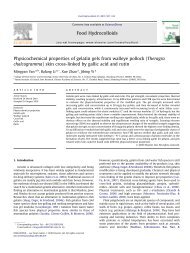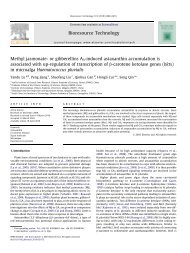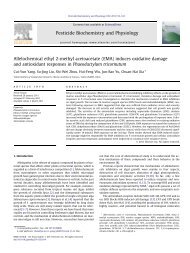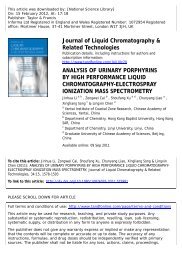Geochemistry of organic carbon and nitrogen in surface ... - YIC-IR
Geochemistry of organic carbon and nitrogen in surface ... - YIC-IR
Geochemistry of organic carbon and nitrogen in surface ... - YIC-IR
Create successful ePaper yourself
Turn your PDF publications into a flip-book with our unique Google optimized e-Paper software.
1150 X. Gao et al. / Mar<strong>in</strong>e Pollution Bullet<strong>in</strong> 64 (2012) 1148–1155<br />
2.3. Statistical analysis<br />
Statistical analyses were performed with the Micros<strong>of</strong>t Excel<br />
2010 for W<strong>in</strong>dows. The relationships between variables were<br />
based on Pearson’s correlation coefficients.<br />
3. Results <strong>and</strong> discussion<br />
3.1. TOC <strong>and</strong> TN <strong>in</strong> coastal Bohai Bay <strong>surface</strong> sediments<br />
As shown <strong>in</strong> Fig. 2, it is clear that TOC <strong>and</strong> TN concentrations decrease<br />
seaward along all the studied transects except the Duliujian<br />
River-T one, imply<strong>in</strong>g that the anthropogenic waste <strong>in</strong>put through<br />
river discharge is a key source for the accumulation <strong>of</strong> <strong>organic</strong> matter<br />
<strong>in</strong> coastal Bohai Bay <strong>surface</strong> sediments. TOC concentrations<br />
vary <strong>in</strong> a wide range <strong>of</strong> 0.85–7.24% (mean 2.30 ± 1.27%). The spatial<br />
difference <strong>of</strong> TOC contents among river<strong>in</strong>e sediments is significant.<br />
The average TOC concentration <strong>in</strong> sediments from river<strong>in</strong>e sites is<br />
3.18 ± 1.38%. Three samples, HH-1, DH-2 <strong>and</strong> DH-3, from Hai River<br />
<strong>and</strong> Dou River, have the TOC contents <strong>of</strong> 7.24%, 4.89% <strong>and</strong> 5.90%,<br />
respectively, be<strong>in</strong>g obviously higher than that <strong>of</strong> the rest samples.<br />
The TOC contents <strong>in</strong> sediments from mar<strong>in</strong>e sites fluctuate between<br />
1% <strong>and</strong> 2% with only a few exceptions, averag<strong>in</strong>g<br />
1.62 ± 0.32%. It was reported that the TOC contents <strong>in</strong> <strong>surface</strong> sediments<br />
<strong>of</strong> Bohai Sea ranged broadly from 0.04% to 0.69% with a<br />
mean <strong>of</strong> 0.38 ± 0.17% (Hu et al., 2009). Compared with Bohai Sea,<br />
the TOC contents <strong>in</strong> <strong>surface</strong> sediments <strong>of</strong> coastal Bohai Bay are<br />
apparently higher, which may be due to the fact that the <strong>organic</strong><br />
matter <strong>in</strong>put to Bohai Bay sediment is strongly <strong>in</strong>fluenced by both<br />
terrestrial <strong>and</strong> anthropogenic sources. Like TOC, the TN values also<br />
show a wide variation range <strong>of</strong> 0.03–0.47% with a mean <strong>of</strong><br />
0.14 ± 0.08% <strong>in</strong> <strong>surface</strong> sediments <strong>of</strong> coastal Bohai Bay, which are<br />
wider <strong>and</strong> higher than the reported Bohai Sea’s 0.01–0.10% <strong>and</strong><br />
0.06 ± 0.02% (Hu et al., 2009). The average TN concentrations <strong>in</strong> river<strong>in</strong>e<br />
<strong>and</strong> mar<strong>in</strong>e sediments are 0.19 ± 0.09% <strong>and</strong> 0.09 ± 0.02%,<br />
respectively. The spatial distribution <strong>of</strong> TN contents is similar to<br />
that <strong>of</strong> sedimentary <strong>organic</strong> <strong>carbon</strong> (Fig. 2). There is a good l<strong>in</strong>ear<br />
relationship be<strong>in</strong>g significant at P < 0.001 between TOC% <strong>and</strong> TN%<br />
as shown <strong>in</strong> Fig. 3.<br />
Gra<strong>in</strong> size composition is an important factor that greatly <strong>in</strong>fluences<br />
the geochemical behaviors <strong>of</strong> elements <strong>in</strong> sediments. The<br />
ternary diagram <strong>in</strong> Fig. 4 categorizes the sediments <strong>of</strong> <strong>in</strong>tertidal<br />
Bohai Bay accord<strong>in</strong>g to the classification <strong>of</strong> Shepard (1954). Sediments<br />
<strong>in</strong> the studied area ma<strong>in</strong>ly consisted <strong>of</strong> f<strong>in</strong>e particles with<br />
the gra<strong>in</strong> size








